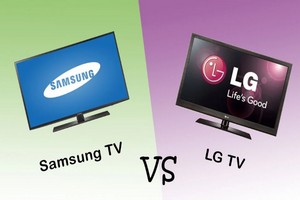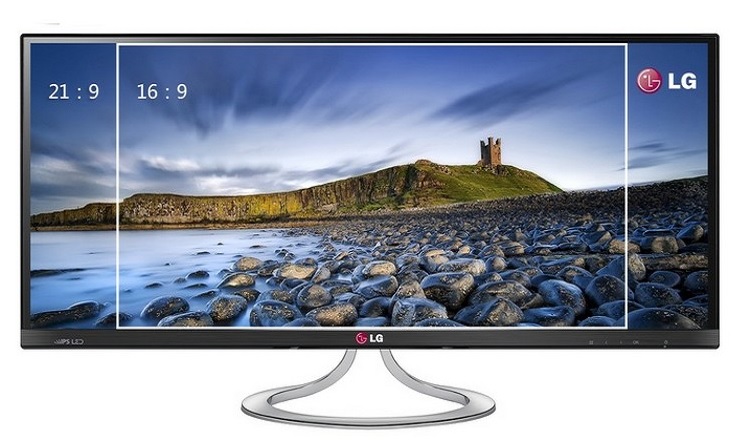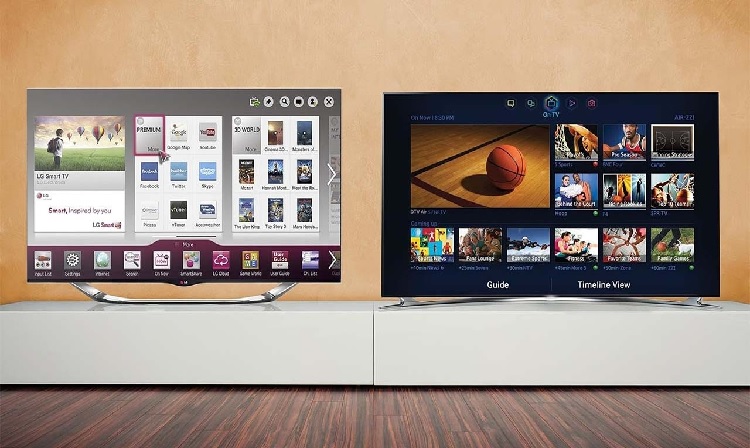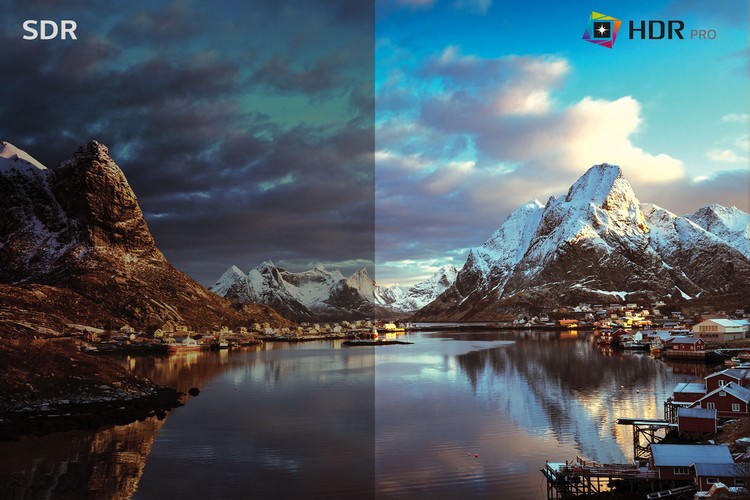Which TV is better - LG or Samsung: comparison of features, prices, image quality
 LG and Samsung are corporations with a worldwide reputation. Both brands compete in the electronics and home appliances segment. Against the backdrop of growing competition, it is difficult to single out a leading TV manufacturer.
LG and Samsung are corporations with a worldwide reputation. Both brands compete in the electronics and home appliances segment. Against the backdrop of growing competition, it is difficult to single out a leading TV manufacturer.
We will try to identify the best panels through a comparative analysis of models.Consider the quality of video, technology, sound, design and equipment of TVs with other useful options.
Content
Description of brands
The South Korean brand LG Electronics was founded in 1958. The company has accumulated extensive technological experience and confidently stepped into the advanced digital era. Today it is a smart and fast brand with the status of a global company, developing innovative technologies of the future.
The history of competing Korean brand Samsung began in 1969. The company is constantly expanding the production of strategic products, introducing outstanding technology, innovative design. Today, the corporation is considered a global technology leader producing premium devices.
Brand differences
In the segment of television technology, there are practically no differences between brands. Samsung is positioning a more subtle approach to the buyer, LG is promoting an aggressive policy designed for young people.
The technique itself differs in the location of the connectors, the type of matrix, design, screen backlight technology.
Which brand of TV technology is better - LG or Samsung
Consider the technology of South Korean brands.
Matrix type: VA vs IPS
Samsung uses a VA matrix.The image is voluminous, sharp, clear, contrasting, but with smaller viewing angles. The technology is suitable for those who look at the screen strictly straight or with a slight deviation, in bright light or, conversely, in the dark.
LG matrix technology - IPS. The picture looks softer, without sharp drops, with wide viewing angles. This is appropriate when viewing content from different points in the room.
However, the panel loses a little to VA in black level. In 2024-2025 models, this is offset by the direct backlight of the Full Array Local Dimming screen. This TV is comfortable to watch in the dark.
Dolby Vision and HDR 10
Samsung supports HDR 10+ technology (Peak Illuminator, 10-bit color). The brand managed to achieve clear detail, color reproduction, and a realistic picture.
The content reproduction quality is at the level of professional digital video filming. HDR 10+ recommended for Google Play video source.
LG supports Dolby Vision technology with 12-bit color. The format gives an equally high-quality image. Works great when watching video sources such as Apple TV, Netflix.
Processors
Samsung's latest Neo Quantum processor is equipped with the latest scaling technology. The panel receives the highest possible resolution, the highest definition detail.
The picture does not depend on the image quality of the source. The chip guarantees the fastest possible response, the effect of complete immersion.
Competing LG models are equipped with a7 Gen3 processor.The chip demonstrates the same characteristics, is not inferior to its Korean counterpart in terms of dynamics, sound control, and response speed.
LG's fourth-generation signal chip is responsible for processing the 8K Alpha9 image. With such a processor, low-res content looks really great.
Tizen vs. webOS
The operating system affects the speed of access to content.
Samsung Smart TV platform uses Tizen, LG uses webOS, a full-featured built-in web browser with a minimalistic design.
At the bottom of the screen, the user selects applications, features, streaming platforms. Artificial intelligence ThinQ AI displays tips, recommendations for viewing.
Samsung conveniently groups functions into menus, which is more comfortable. Switching between on-air and online content is seamless. Games, any content are available in the cloud storage. It is easier to connect tablets and mobile devices to the TV. You can stream video from your smartphone to your TV and from your TV to your smartphone. Samsung's new Smart TV platform gives you freedom of choice in entertainment and content viewing.
Both systems are fast, have many applications, and have clean signal processing. The choice is a matter of consumer taste.
OLED and QLED
LG uses OLED backlight matrix. The principle is based on organic light emitting diodes (hence the name - Organic Light Emitting Diodes).
Within a few years, the previously expensive technology entered mass production and became available to most users. LG has created a stunning OLED screen, a truly effective HDR.
Characteristics:
- Each pixel lights up with a specific color.The screen reflects the true depth of black, demonstrate amazing contrast, vivid colors. Advanced rendering allowed the brand to achieve a completely black color.
- The high speed control of a single pixel of the matrix contributes to low power consumption.
- 99% DCI-P3 color space available, 10-bit color depth. The technology reproduces magnificent colors especially when scaling the picture.
- The viewing angle is 160 degrees.
- 0.001ms refresh rate covers the smoothness of the picture when playing dynamic scenes
The OLED screen is practically glare-free, suitable for bright rooms, making it comfortable to view in the dark. The viewing angles are as wide as possible. The backlight gives great colors on the screen, reproduces 20 levels of brightness. Peak brightness is up to 1000 nits, which is impressive.
Samsung has achieved impressive parameters using QLED (Nano-Crystal, Quantum Dot) quantum dot technology. The main difference from OLED is a wider coverage of the color range.
Characteristics:
- The standard LED matrix is backlit with LEDs, resulting in a wider, richer color gamut and more vibrant colors. The technology easily outputs 1000 nits brightness, high response. More than a billion different color combinations are displayed on the screen.
- The application of the new scaling ensures optimal backlighting, producing brighter, more realistic images. This will appeal to fans of sports programs and blockbusters.
The picture contrast in QLED is lower than in OLED.
TV Specifications
Consider the main characteristics of the panels.
Price-quality ratio
Samsung manufactures and sells more low-end models, which is why it overtakes LG in terms of sales.
With equal technical parameters, Samsung TVs are 7-10% more expensive. Most consumers prefer to buy premium segment models from LG.
Image quality
The quality of the picture with equal technical parameters is almost identical. Only a few nuances can be highlighted.
Samsung's QLED (or more advanced SUHD) display is brighter and clearer. The latest models have received maximum detail and contrast.
Quantum Matrix Pro technology with Quantum Mini miniature LEDs creates the sharpest picture with very accurate backlighting and deep blacks.
Brand models clearly display all the nuances, for example, the display of sunlight, car numbers, reflections of objects on the water, fire in battle scenes. Samsung surpasses the competitor in color gamut, clarity, detail.
LG has focused on the naturalness of the image, the best display of the entire spectrum of dark colors. Televisions are distinguished by a wide viewing angle. The user has access to the benefits in 3D mode.
Among the shortcomings - weaker contrast at the edges. The picture suffers in highly dynamic scenes, revealing slightly blurred movements.
In panels with HDR Pro technology, the picture received an ideal change in brightness, realism. Adjusting the black level, brightness is a very high range.
LG's infinite contrast is realized with Infinite Contrast technology. In a matrix with organic light-emitting diodes, individual pixel brightness is realized up to complete blackout.
Sound quality
Samsung's sound scheme produces a good soundtrack. The panel features are sufficient for comfortable perception.SRS Theater Sound technology improves clarity, automatically adjusts the volume depending on the picture.
However, music and concert programs look standard. The manufacturer advises using a soundbar for the highest possible sound quality.
LG likes to build in powerful bass speakers. Subwoofers provide great depth, volume, high quality sound. Clear Voice technology is provided, which transmits natural-sounding voices while muting background noise.
However, this is not enough for excellent multi-channel sound - this will require an external soundbar.
Pretty decent sound of LG panels, Samsung provides good clarity of voices, a certain level of bass. Functions and settings allow you to make the sound base wider, adapt the sound to the content you are watching.
However, all models will benefit from a separate soundbar. The soundbar will provide a more immersive, immersive viewing experience.
Screen aspect ratio
Samsung and LG prefer widescreen models. The range of TVs is presented in 16:9 screen format.

Diagonal
Samsung produces screens in sizes 32, 43, 50, 55, 65, 75, 85''.
Competing LG - 48, 55, 65, 77, 83, 88''.
When buying a model with a large screen, it is recommended to choose a resolution of at least 4K. When equipping a home theater - a screen of 45 inches. Both brands have implemented high picture quality at any diagonal.
Video call
LG panels do not have a built-in webcam, there is no Skype calling option.Samsung has such a licensed call.
Which Smart TVs are better - LG or Samsung
LG comes with a great, easy-to-manage webOS browser.
The intelligent platform works well, offers wide settings, and is characterized by unparalleled color reproduction. There is voice control, search is implemented using the virtual keyboard, which is very convenient.
Samsung Tizen demonstrates the best color saturation, high-quality graphics.
OS features high speed without freezes. The user receives free widgets for IPTV, which wins over a competitor. The brand offers convenient control, interface, and a wide range of applications.
Design of LG and Samsung TVs
LG makes models in gorgeous slim designs with a semi-circular or swivel base. The design of the TVs is light, the manufacturer has achieved a minimum display thickness of just over 0.8 inches (2.57 mm).
Only this brand has really moved away from "thick" panels, since OLED does not require a backlight system. The technique independently uses internal lighting and comes to the absolute minimum of a physical panel.
The style of the TV is the pinnacle of sophistication. Minimalistic design, very thin front frames do not distract attention while viewing and give the technique a nice look. There is a possibility of installation on a wall.
The Samsung feature is a curved screen. It involves the mind as much as possible in the ongoing action, but limits the viewing angle. Simple models are made in a surprisingly thin body. Stands are mostly square or oval, with the exception of LED panels.
Samsung designed the Infinity One to be the slimmest profile yet. The manufacturer has practically removed the black frames. The borderless screen has received a new degree of immersion, realism of viewing.The technology looks modern and elegant.
The wall mount will help you hang the panel close to the wall.
Which TV is best for game console
Samsung 4K QLED TVs are characterized by wide gaming capabilities.
Gamers love multi-dimensional, immersive sound, and the ability to connect to compatible soundbars. The multi-view function is also relevant. The option allows you to watch game videos and other content during your favorite game.
LG is not inferior to fellow in technical parameters. TVs with a large diagonal, fast response, high refresh rate provide a quality game. However, flagship models are cheaper than Samsung. The choice again remains a matter of taste of the buyer.
Useful video
So, which TV is better - LG or Samsung? Watch a short video and draw your own conclusions:









